
3DShipWright
-
Posts
203 -
Joined
-
Last visited
Content Type
Profiles
Forums
Gallery
Events
Posts posted by 3DShipWright
-
-
Quick update:
- Starting to add ornamentation to the stern gallery, quarter galleries, and deck houses
- Color theme changed to a more 'classic' black and white theme, with patinaed (both copper and bronze) sculptures
- Rudder end cap completed
- Bolts finished on the gudgeon and pintle straps
- + much more not shown in this particular screenshot... addl updates to follow soon!
.png.58216ef9e1f0210c6c6a1437e3e0f9ba.png)
-
@Martes - moving our conversation to the build log as others may benefit from your advice as well.
Okay, so I've done a quick and dirty fix to the 1st problem area you pointed out. A couple things: I do think for this to work, I will have to do the section immediately aft as well. also, I did my best to move the camera angle so the sun illuminates the top of each strake so we can see what's happening from top to bottom as you look down the hull (not sure it'll come out in the compressed photos though).
Here's the before and after shots...
1. Before
2. After
I am getting a slight 'warp' in the wale because, technically speaking, the additional smoothing would have to be perpendicular to the normals (i.e. normal tangent) and not just global XYZ to be correct. Still, it's encouraging that this may be easier to do than I initially thought.
Thx,
-Nate
-
Under the hood shot of the deck beam and framing. As it seems to be working well for this project, I once again modelled general shapes first, then gradually upped the detail and sophistication in subsequent passes and/or working sessions. About 50% done with the deck framing, at which point I'll move on to partitions, hanging knees (knee braces), and then the 'fixed' fittings.
-
This is the first of about a dozen relief sculptures that outline Confederacy's stern. I will use two organic characters I modelled from scratch for a 3D anatomy class I'm taking online - one male, one female - to get all the sculptures added to the stern. I will then use their armatures to not only pose them properly, but to change their facial features and body types subtly, so that hopefully in the final product they will look as if each one was carved individually, and so they don't look like clones of one another (even if in fact they are).
Her hair is a different story. This will be the only time in this project that I use 3rd party models. I've decided to spend the $5-$10 bucks and buy a real-time hair pack from an online marketplace.
Note: This one was very hastily posed, at this point I'm simply getting a feel for approx size as well as experimenting with how to get the cloth simulation to drape her skirt in a way that it looks like wood. Ironic, isn't it... cloth made to look like would that was sculpted to look like cloth?

Anyway, here she is...
.png.86db05ade088cb29b429cbe1aedc98e6.png)
- scrubbyj427, CDR_Ret, mtaylor and 3 others
-
 6
6
-
-
A Proper Rudder!
.png.9339b0a0f9b46e145b96ec08325fb33d.png)
.png.dc70f97b18580159f4e09ec6ec0adcc0.png)
- mtaylor, wernerweiss and Montaigne
-
 3
3
-
And we have a winner! Bear in mind this is a preview of the color theme only... The actual texturing will take months and will look much, much better

To give you all an idea - I haven't even UV unwrapped everything yet. I just wanted a break from modelling. Still, not in bad shape for the 3 month mark.
.png.48b8d0a16335b56c68312dcd0760cb5d.png)
- scrubbyj427, wernerweiss, Montaigne and 5 others
-
 8
8
-
- scrubbyj427, CDR_Ret, chris watton and 1 other
-
 3
3
-
 1
1
-
- Montaigne, wernerweiss, CDR_Ret and 1 other
-
 4
4
-
Good news is this is an easy issue to solve... Your problem is that your frames are way too thin. Even when using a uniform thickness due to the solidify modifier, the thickness of the frames should be, I'd guess, no less than 8-10 inches. Start with that and go from there.

Best,
-Nate
-
4 hours ago, Martes said:
Also, boolean can come in conflict with mirror, especially if both objects have mirror before boolean is applied, and generate mirrored geometry inside the mesh.
Good point! Along time ago I simply got in the habit of ensuring any and all mirror modifiers I use go to the very bottom of the stack... that way, you can mitigate potential issues.
-
Well done Sir! She's a beauty.
- Ryland Craze, mtaylor, FriedClams and 4 others
-
 6
6
-
 1
1
-
Keep in mind the boolean does leave behind a messy topology, but you can quickly clean it up by selecting all horizontal edges by selecting a couple from each part, using the select similar -> direction to get all 'intentional' horizontal edges, then press numpad 1 to select the vertices that comprise those edges, then ctrl + I to select any messy verts left over from the boolean, then finally delete -> dissolve vertices
Hope that helps,
-Nate
-
-
3 hours ago, Maddog Shipyards said:
- Make sure your 6x6 "plank" origin, generally the midpoint of the bottom edge, is the same as your body line, which should be sitting on the rabbet.
- I had to twist all the paths by 90 degrees to get the correct orientation, and I used the "Switch Direction" command to make sure it went the right way.
- In order to use the top two vertices to stretch to your wales/rails, make sure you enable "Display Modifier in Edit Mode"
Excellent start... and yes, I extensively used all three fixes you listed above, I just didn't list them because the tutorial I made was already hard enough to follow, and I assumed anyone that could follow it would also be able to figure out the 'change direction' hack on the curve segments and how to enable the modifier views correctly in edit mode. On a side note, its truly irritating that Blender can't figure out that a series of curves that all start from z=0 on the world plane should be pointing the same direction, but oh well...
I too own the AOS Pandora book, and in that book, note the complexity of the outer planking. in fact for my Confederacy build, I mimicked Pandora's hook-and-butt joints along the main wale, as well as how certain planks widen. to meet the gun ports in key spots.
Anyway, great job - excited to follow your progress.
-Nate
-
@Martes - Yep, agree with everything you just said, a couple things:
The height of the copper plating isn't really something I can fix at this point sadly. I mean - I could of course, but it's unnecessary work given my final renders will have the ship in water. I hate to use that as an excuse, but technically speaking, Rose is already rife with problems, so I want to spend more of the remaining time on this project honing my lighting, compositing, and visual effects abilities. I have, however, sunk her down to the appropriate level in final renders.
.png.d2cf0bec71b28f2784b2ffd3e844dc61.png)
2. The rings will be removed. When I previously said I saw these on historical plans, I now believe I was confusing modern-era dry-dock mounts with 18th century deck scuppers, which wouldn't be at that level on a small brig, if at all.
3. Finally, I will be replacing the union jack with a real Royal Navy flag from the time. The challenge is finding or color grading a texture to match the sail cloth material. Again, I can do this, but I want to finish up the rigging 1st.
-Nate
-
Hey Everyone,
I will be posting a major update to Rose shortly, hopefully one of the 2 or 3 final updates before I can stamp the word 'FINISHED' on the thread. That said, as I can't put Rose on a shelf in my bedroom or home office, I'd envisioned doing a series of epic renders with her, rife with special effects and postprocessing... which brings me to my question for the community:
Would any 3D Artist out there be interested in doing a compilation collaboration - gotta love the alliteration - with me on a naval battle, perhaps; effectively a modern take on those classical maritime paintings I'd venture to say we all love?
It will be a while, granted, but I wanted to put a feeler out there to see if anyone else would be interested...
Thx,
-Nate
-
@Martes - So I'm revisiting Rose a bit this morning... gotta say, thanks to yourself and others on this forum, my nautical/historical understanding has come a long way since I started this project. For example, you once asked me what the rectangular linen boxes were inside the hammock cranes as hammocks were packed into cylindrical containers...
.png.d8ab635d788db8983ae8ae3e49b6cbb6.png)
I now have the correct answer:
The USS Brig Niagara, like the USS Constitution, is an operational to this day, but unlike the constitution, Niagara offers day trips to the public. Thus, she is subject to the laws of the USS Coast Guard. So, in an effort to preserve the historical feel, adult lifejackets are stored in the hammock cranes in sacks that mimic the linen of the time... A nice touch by the Pennsylvania Historical Society, if you ask me. I am still removing them from the final model, but just thought I'd share

-
@Maddog Shipyards - Excellent question re: UV unwrapping... So I'll give you a few different answers/things to consider.
-
The whole 'low-poly' concept for real-time applications (i.e. Unity, Unreal, etc.) is widely misunderstood. Keeping a low poly count is mainly important for models used in particle systems like trees/vegitation, or not letting it get to a crazy-high number in models that are complex by nature such as people and animals. Just FYI - buildings, unless you're re-creating a gothic cathedral, should be easy to keep low. Having said that, there is an argument to be made that a game that takes place on the ocean would need all environment models (i.e. boats and ships) to be low-poly because the ocean itself has to be fairly complex geometry in order to look good. Luckily, there's a very convincing work-around: The trick is to layer 2 ocean modifiers on top of each other. The first is a large scale, low-poly plane that will act as the underlying 'waves' or 'swells'. The second is a small-scale, super high-poly ocean modifier that mimics the ripples. Both are baked into a displacement map, but only the large scale displacement is used to displace geometry while the high poly is simply a bump map. The results look like this, and surprisingly - the entire ocean has far less polys than the ship itself:
.png.bdeb1aca556eff18a37ae182f966ee7d.png)
- The 'professional' 3D workflow used by major studios is modelling -> re-topology -> UV unwrapping/texturing -> 3D rigging (not to be confused with rigging on a ship) -> animation (or baked animations - which Blender calls 'actions' - for use in video games).
-
Professional studios have teams of people whos full-time jobs it is to do a specific step in the above workflow. Ergo, as an individual artist, I actually find it easiest to use this rule of thumb: UV unwrapping/texturing should be done in a way that prevents duplicating work. Therefore, I will hold off at least until I'm satisfied that a particular portion is finished from a modelling perspective. However there are two scerarios where you want to texture earlier in the process. they are:
- Things I'm going to reuse multiple times. (Example: anchors, barrels, bollards, cannons, cleats, columns, deadeyes, grates, lanterns, staircases... you get the idea)
- Anything that requires an array modifier. (Example: chain links and rope segments... plus maybe a couple little things I'm missing)
Hope this helps,
-Nate
-
The whole 'low-poly' concept for real-time applications (i.e. Unity, Unreal, etc.) is widely misunderstood. Keeping a low poly count is mainly important for models used in particle systems like trees/vegitation, or not letting it get to a crazy-high number in models that are complex by nature such as people and animals. Just FYI - buildings, unless you're re-creating a gothic cathedral, should be easy to keep low. Having said that, there is an argument to be made that a game that takes place on the ocean would need all environment models (i.e. boats and ships) to be low-poly because the ocean itself has to be fairly complex geometry in order to look good. Luckily, there's a very convincing work-around: The trick is to layer 2 ocean modifiers on top of each other. The first is a large scale, low-poly plane that will act as the underlying 'waves' or 'swells'. The second is a small-scale, super high-poly ocean modifier that mimics the ripples. Both are baked into a displacement map, but only the large scale displacement is used to displace geometry while the high poly is simply a bump map. The results look like this, and surprisingly - the entire ocean has far less polys than the ship itself:
-
Thank you Maddog!
So years ago, one of my 3D mentors once told me, "At the end of the day, there is no substitute for actual geometry."
Weighing in at 6,076,131 vertices and 6,085,643 polys, Rose (a fictional brig - named after the original HMS Rose replica, titled HMS Surprise for the Master and Commander film) is proof of that idea. Even so, I think I would amend that to say, "There is no substitute for actual geometry... where it counts."
As to figuring out precisely where that is, well, there in lies the rub, as they say.
Best,
-Nate
-
Hey Everyone,
So it's been a while since I last updated, and I'm pleased to announce the project is progressing, albeit at what feels like a snail's pace. Still, here some of the more noticeable additions/developments:
- Knightheads modelled and placed
- Beakneck doors modelled and placed
- Bobstay separated into its own piece
- Covers placed atop the roundhouses
- Seats of ease modelled and placed inside the roundhouses
- Internal Planking completed from the top of the quarterdeck down through the waterway on the gun deck
- Breastrail modelled and placed on the aft quarterdeck behind the main mast
- 'Confederacy' Name displayed across the upper counter at the stern (The U.S. eventually followed suit of the British practice of not attaching, painting, or otherwise displaying a man-o'war's name on its hull, but not until 1785)
- Channels modelled and placed
- Glass added to windows
- Paneling placed behind window framing on the 'false windows'
- Catheads added with sheaves
- Headtimbers placed using Bezier curves (minor adjustments required)
And now for the screenshots:
.png.20a25754c11106924b121204a026f74f.png)
.png.2c2cdef17872ed821ad16b0bf8278969.png)
.png.9ff469f6d0aeb93daeefe207ac9003ef.png)
.png.86481d2c34d367678373c13e98fc50ad.png)
.png.e870420c22e96b9fe9e4d71b31cffa0e.png)
- bwross11, chris watton, WalrusGuy and 6 others
-
 9
9
-
Okay - gotcha, thx. Yeah, if there's no normal, roughness, specular or bump map data to consider, my question kind of goes out the window lol.
Still, it makes your work that much more impressive as at first glance I thought there was that kind of 3D interpolation going on, especially with the cannons on the lower deck(s).
Thx again.
-
Looks great Martes! Random question - are you baking multiple textures into a single material for each ship? If so, is this something you have a lot of experience with? I'm ashamed to admit I've been hesitent to get into that part of blender, yet I know its an absolute 'must' if I ever want to do detailed ships in a large scale setting, be it a game, video, or render.
Either way, your work continues to impress!
-Nate
-
On 4/29/2023 at 12:28 AM, Martes said:
On a side note, what is quite peculiar, that the her hull lines look neither British, nor French. They appear to be strongly influenced by F. H. af Chapman's "Architectura Navalis Mercatoria" and his "Treatise on shipbuilding". Technically this is entirely possible (the books were published in 1768 and 1775), but very interesting nevertheless as to the why and how was this style chosen, being quite the cutting edge of ship design at the time.
Inviting @wernerweiss and @WalrusGuy as other current Confederacy builders if they'd like to weigh in.
So yes, American frigates, specifically the Confederacy - were/was quite different than anything else out there at the time. The 'why' these choices were made is actually kind of ironic. But in historical context, they make perfect sense.
A few years back, @mtaylorshared an excellent link to letters of correspondence between Confederacy's shipwright and the Continental Congress that shed light on her design and build. For the life of me, I can't seem to find his post again, so I'm paraphrasing from memory here as well as some inferences I drew from the text:
1. Most 'American' (I'm using quotes because the notion of America as a country was in dispute at the time lol) shipwrights were trained in service of the Royal Navy, but when war broke out, they were cut off from the design resources and structure of the British Admiralty. This was both good and bad. On one hand, they were free to break status quo and experiment with more modern techniques, such as Chapman's works, but also the Swiss mathematicians, Bernoulli and Euler.
2. America had superior lumber (specifically species of live oak and other greenwoods), but inferior or simply less availability to copper. In 1781 the American Navy finally followed suit of the English and mandated that all military vessels be lined with copper. However, that's not to suggest they didn't understand it's importance well before that, and my guess is confederacy was intended to be sheathed.
3. Confederacy can best be described as an overly ambitious project and an un-realized dream. At a time when the American Navy had a grand total of 6 warships and a handful of repurposed sloops, the Confederacy was to be the Flagship of the new nation. She was ornate, featured dozens of hand-sculpted carvings, and was stylized in an Italian sub-set of Neo-classical architecture, known as Palladian style.
4. BUT - not only did she repeatedly run out of funding, when the build inevitably ran over schedule, she was rushed out to sea. So instead of a copper hull, she got one of white oak, poorly painted white. In the cold waters of the North Atlantic, white-bottom hulls could stave off large quantities of marine growth. However, a single trip to the Caribbean, the pesky teledo worm had bored enough holes in her hull that wood rot consumed her greenwood framing within a few months. Finally, instead of 38 large caliber guns and several carronades, she left port with 28, comprised solely of 12pdrs and 6 prds.
As I promised my build of her would be as close to historically accurate as possible, I intend to show her [paraphrased]
"Prepped for copper but hastily white-washed below the wale, black wale and top-section, red internal planks, a hull above the wale of 'natural ochre', trims of red, white and blue, and carvings of natural wood." That's a surprising amount of color, and means the typical yellow, black and red as seen on the MSW kit is not actually correct, but to be fair, I don't know if those letters were publicly available when they came out with the kit.


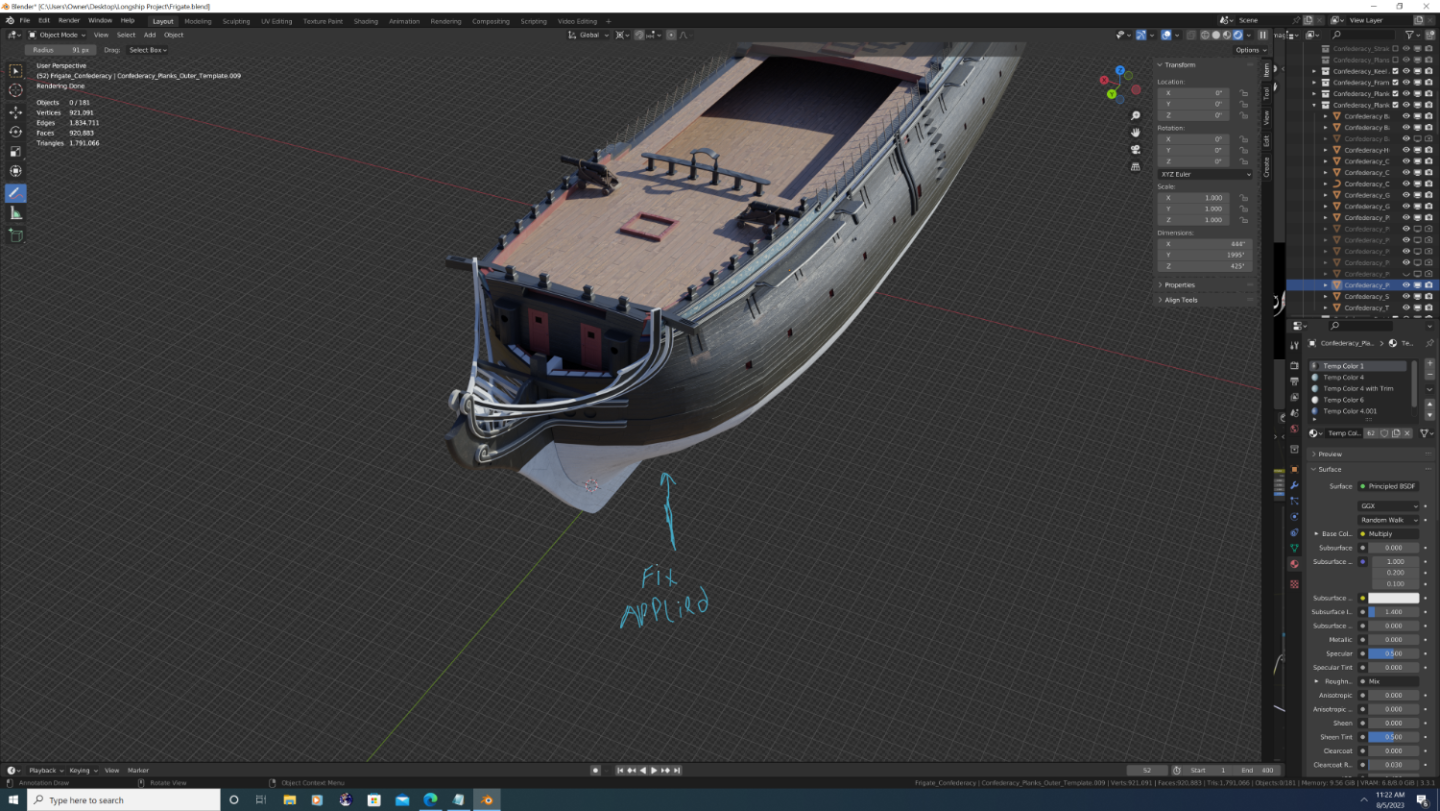
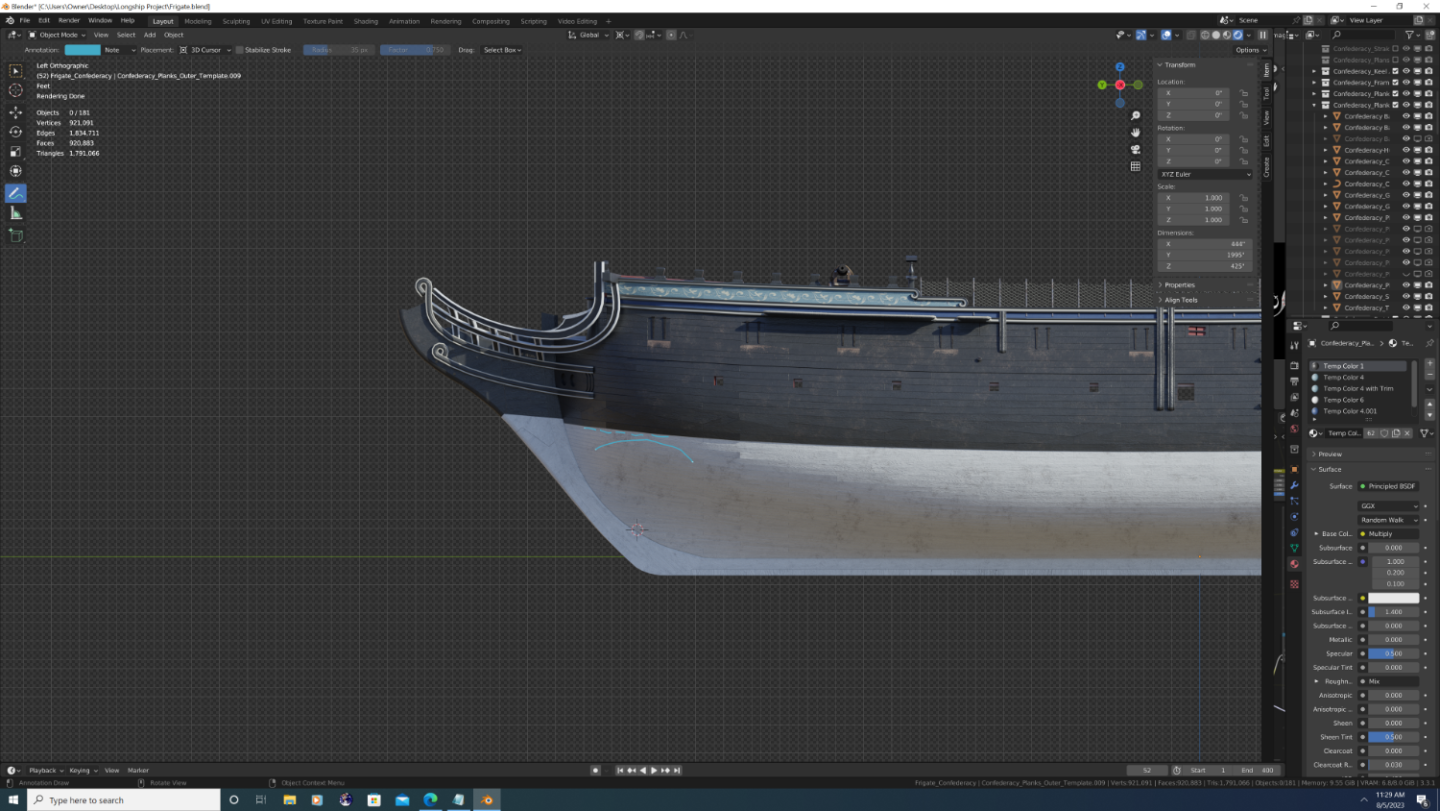
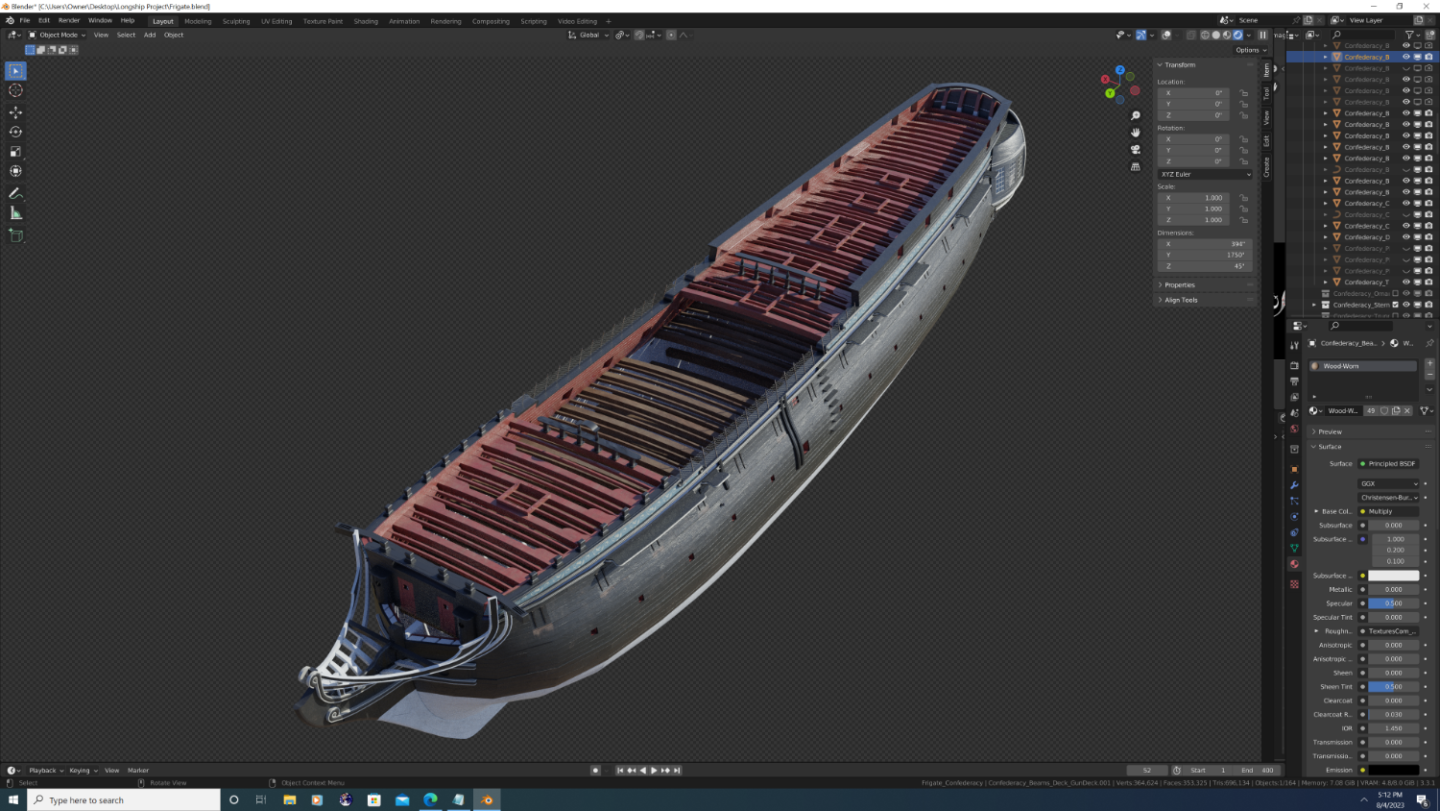
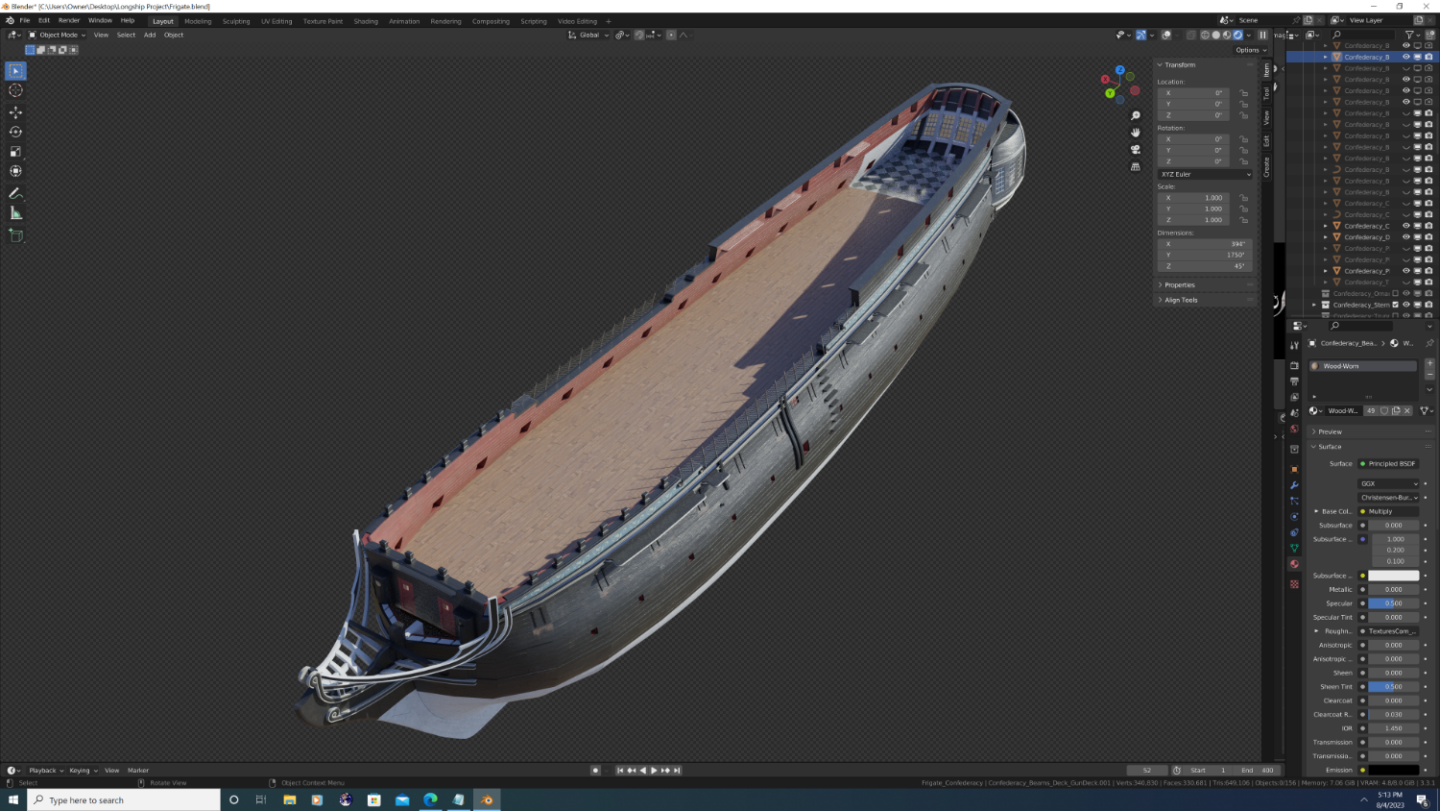
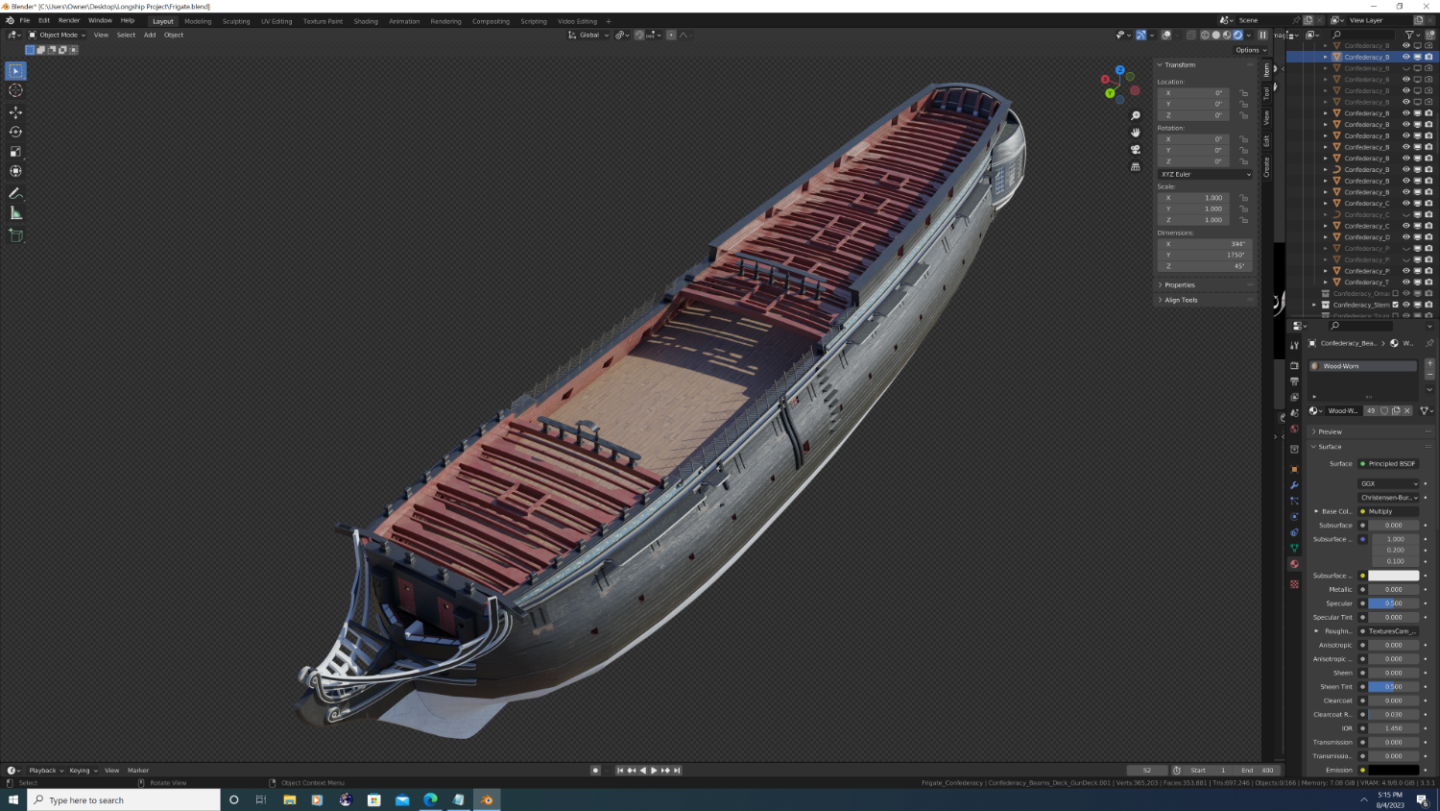
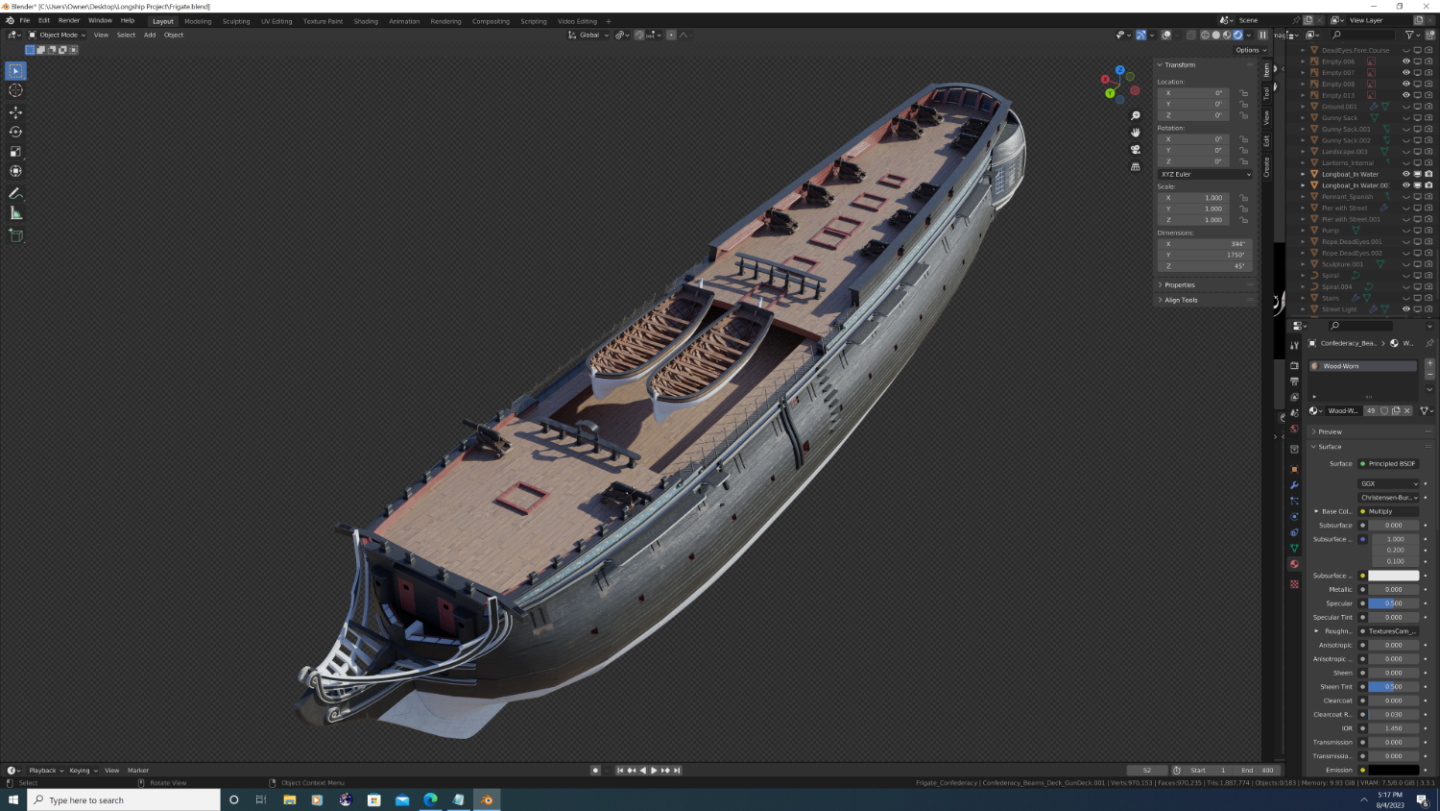
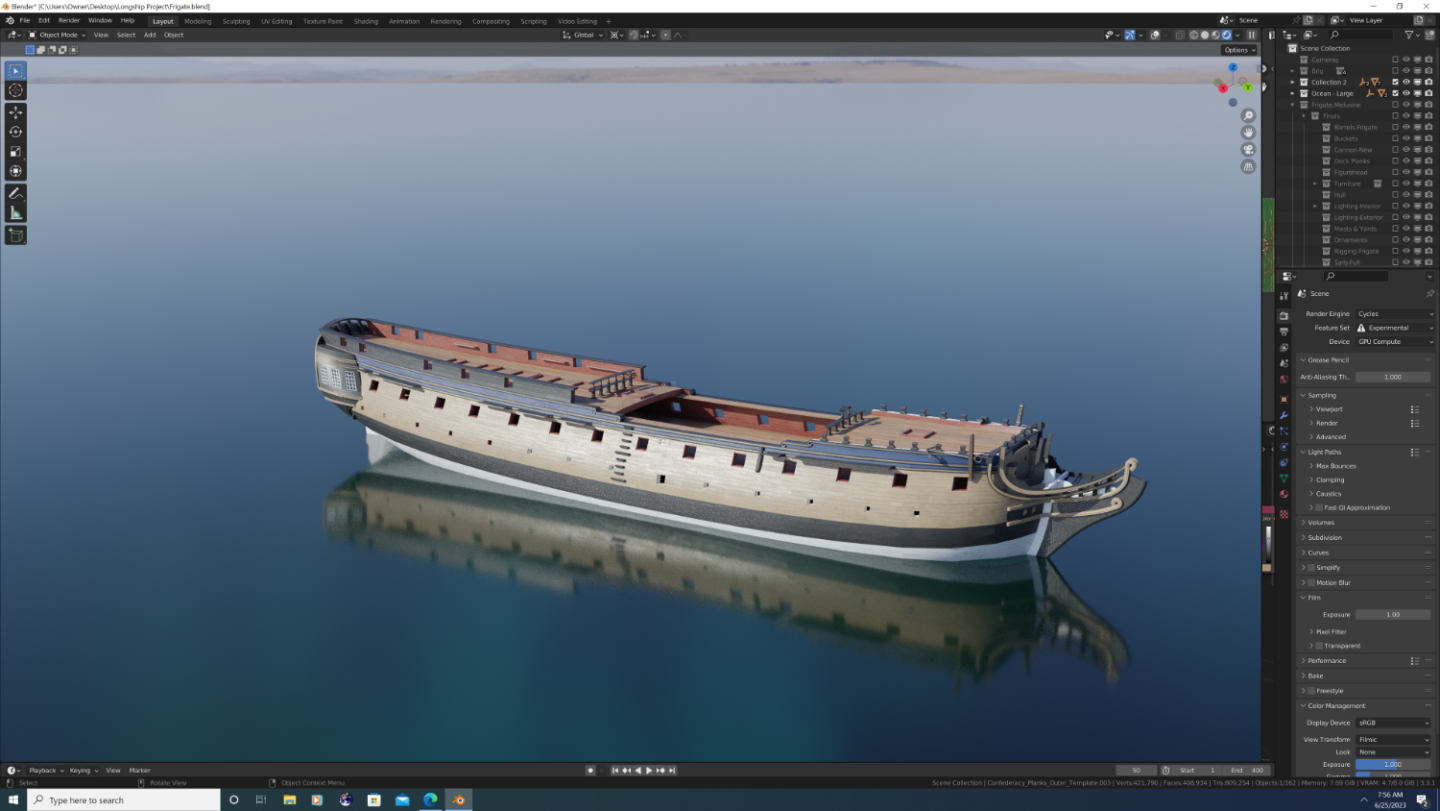
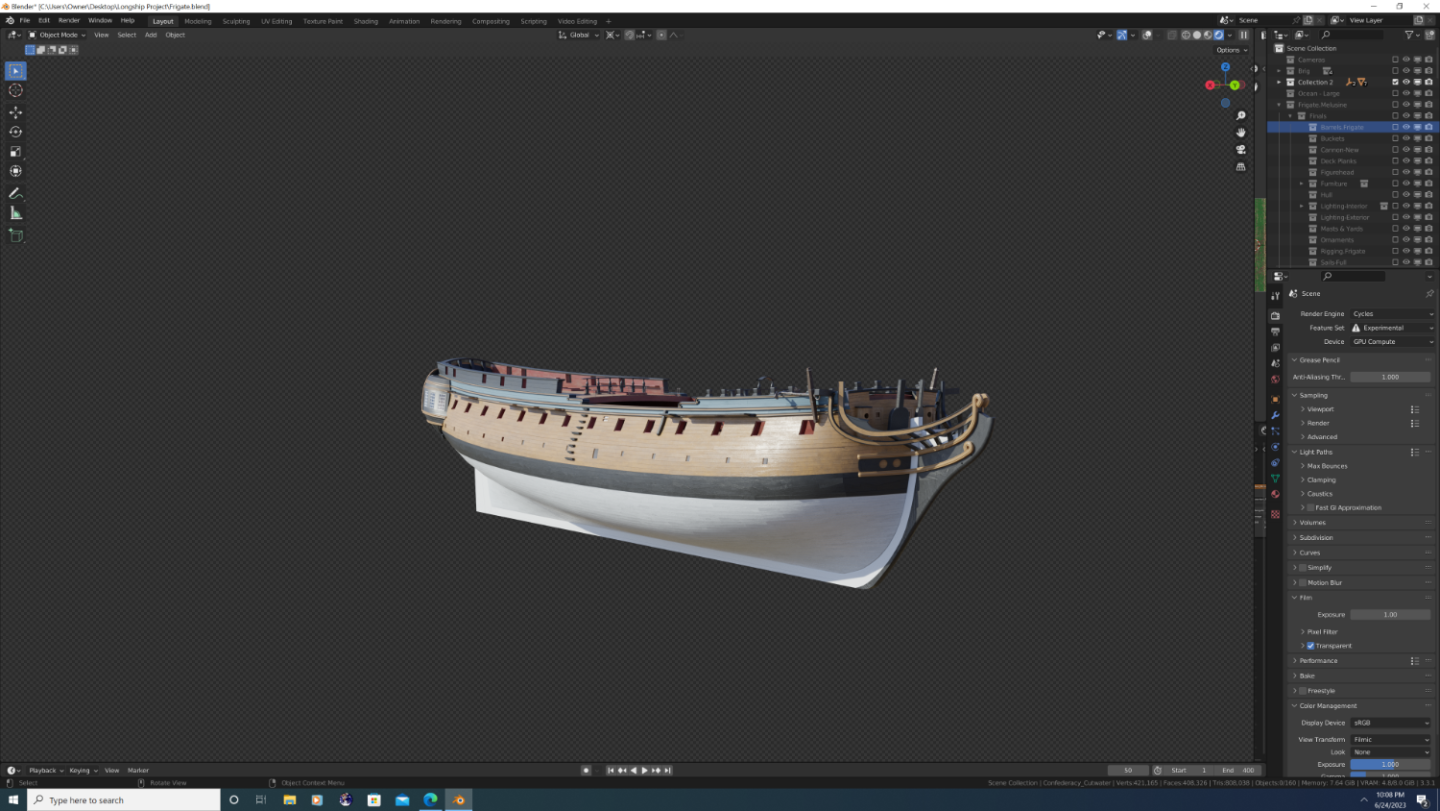
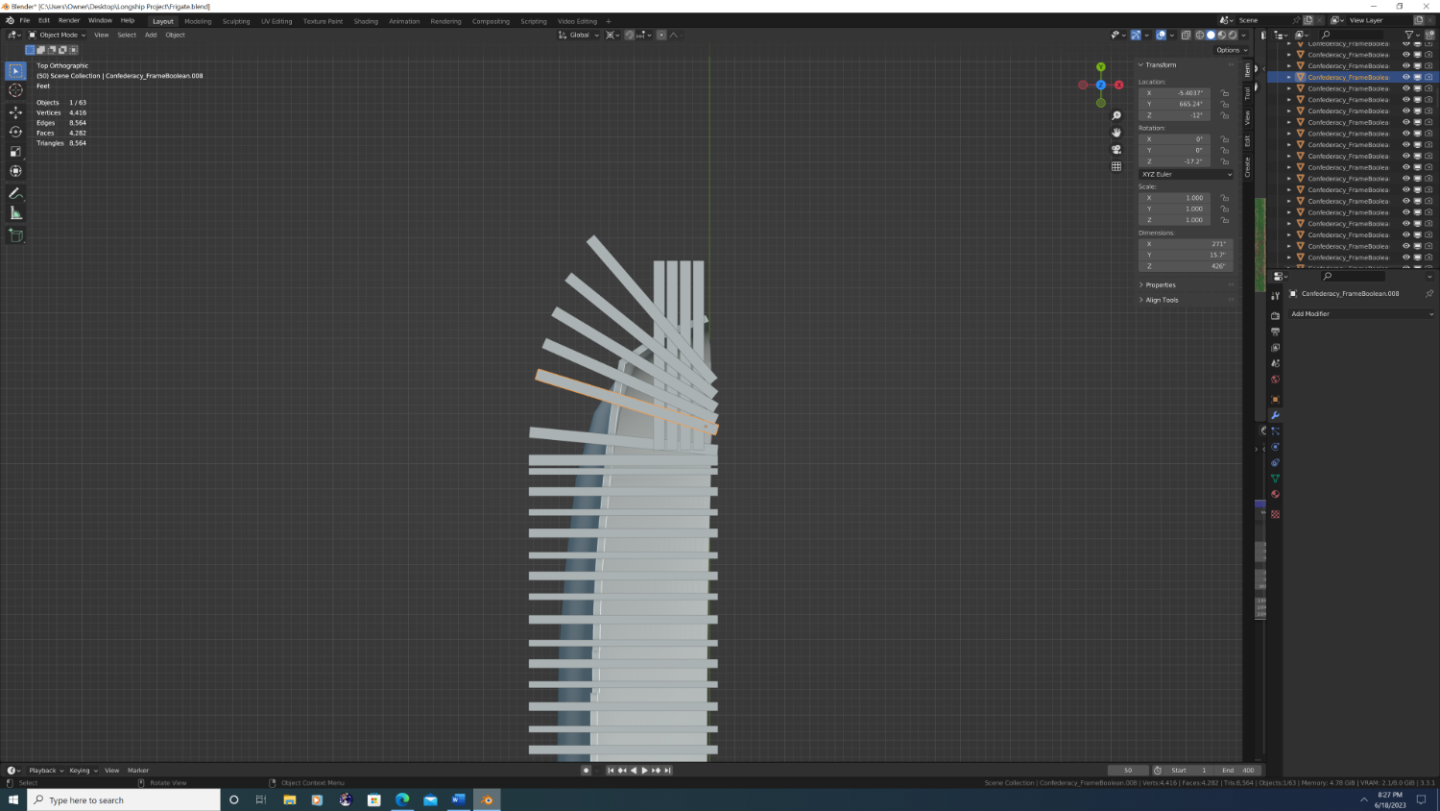
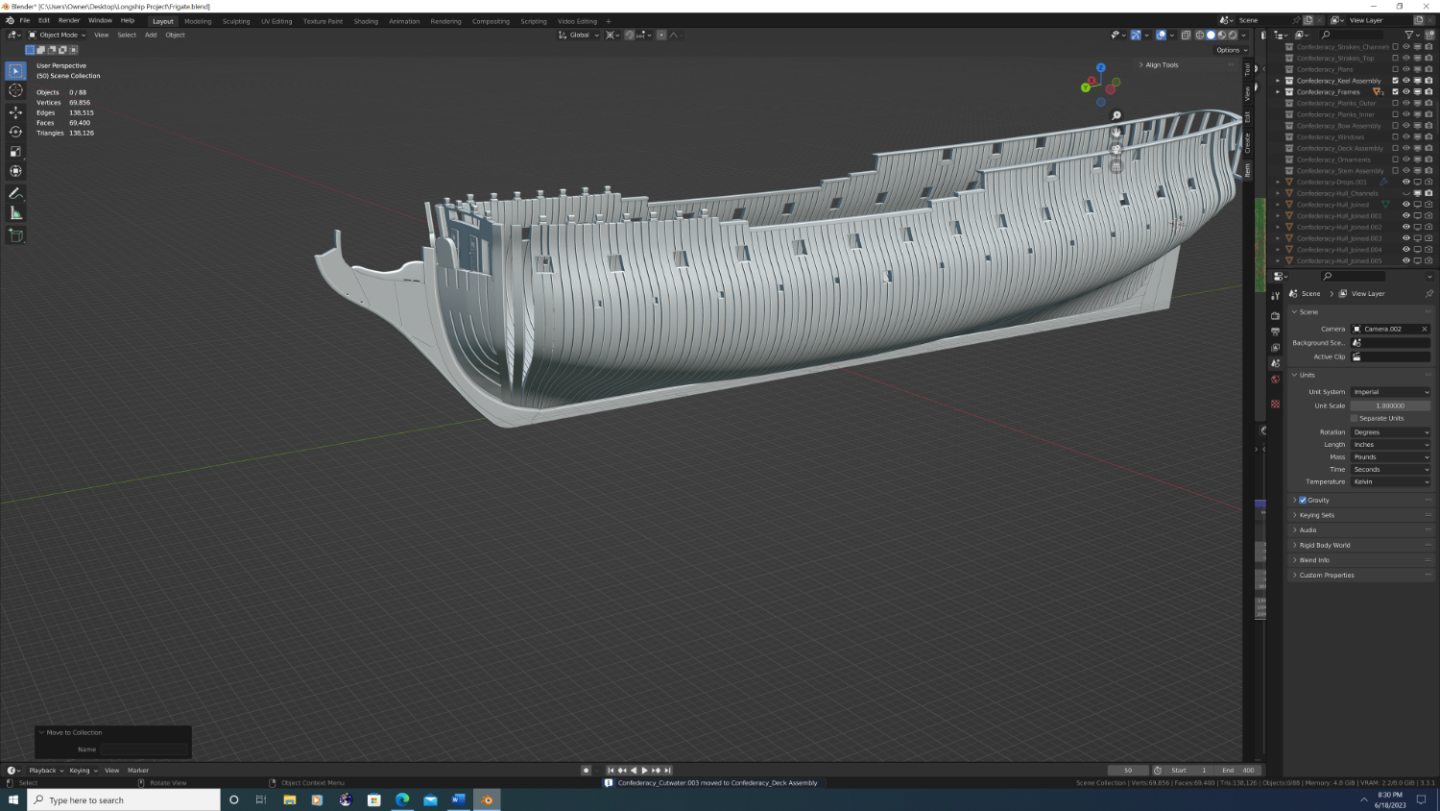
USF Confederacy in 3D | Blender
in CAD and 3D Modelling/Drafting Plans with Software
Posted
@Martes - Hard to see from one screenshot, but if you were to look really close at the texture, I even went so far as to try to mimic a thin layer of bronze/copper atop a wood carving. I do believe the gilding - likely bronze due to copper shortages in the Americas during the revolution - to be historically accurate. The 'patina' material refers to the oxidation of these metals and occurs faster on thin layers. To accomplish this in 3d, I mixed the normal maps of the wood grain smoothly with that of the bronze sculpture material at about a 30-70 percent ratio. I then sharply painted the corrosion (patina) to the cervices (I tried using geometry nodes to calculate where the actual cervices are procedurally, but that proved to be serious overkill). The albedo/diffuse maps only mix the bronze and patina materials, understandably.
As to the question of budget, yes there were funding issues during Confederacy's construction - lots of them! Yet Confederacy was built to impress; to be the unofficial 'flagship' of the American Navy at the time, and ironically, historical letters of correspondence will show that money was in fact wasted on her external beauty while neglecting important things like copper sheathing or even, you know, cannons.
SCREENSHOT REFERENCE KEY:
1. Wood grain normal/bump map visible
2. Bronze normal/bump map visible (Note the chipping and denting effects)
3. Hand-painted patina effect. As an added bit of realism, the patina mapping also controls the metallic shader (Bronze is a ferrous metal, whereas rust and other environmental corrosions diminish these light-based properties)